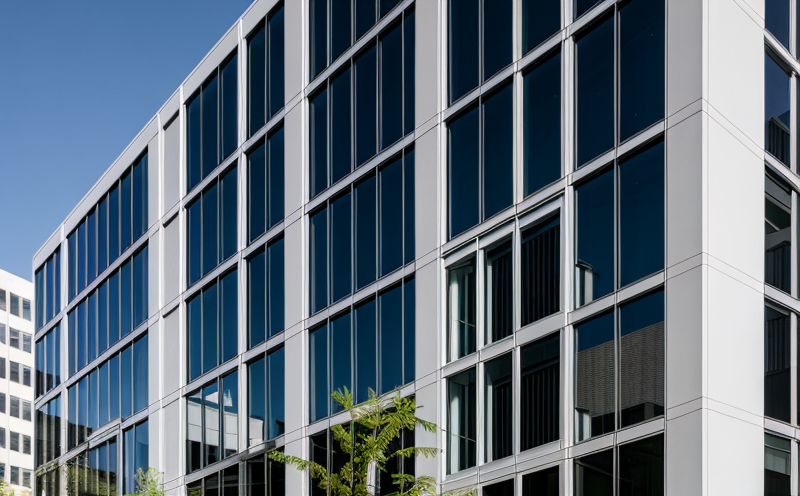ISO 9050 Measurement of Transmittance Properties
The ISO 9050 standard provides a robust framework for measuring transmittance properties, which are critical in the design and performance evaluation of glass, ceramic, and façade materials used in building and infrastructure projects. This service ensures that materials meet stringent optical performance criteria, thereby enhancing the structural integrity and aesthetic appeal of buildings.
The measurement of transmittance is essential for assessing how much light passes through a material without altering its spectral quality. This property is particularly important in modern architecture where energy efficiency, glare control, and visual comfort are key considerations. The ISO 9050 standard outlines precise procedures to ensure that the measurements are accurate and repeatable.
In the context of glass and ceramics, transmittance testing helps architects and engineers select materials that optimize daylighting while minimizing heat gain or loss. For façade systems, this test ensures that the chosen materials do not compromise on safety or energy efficiency. The standard applies to a wide range of materials including flat glass, laminated glass, ceramic tiles, and various types of glazed surfaces.
The testing process involves precise measurement techniques using specialized equipment such as integrating spheres and spectrophotometers. Specimen preparation is critical; the material must be cut or prepared in accordance with the ISO 9050 guidelines to ensure accurate measurements. The environment during testing also plays a crucial role, requiring controlled conditions to minimize external variables.
The results of this test are used by quality managers and compliance officers to verify that materials meet specified performance criteria. R&D engineers rely on these tests to refine material properties for future projects. Procurement teams use the data to ensure they source materials from reliable suppliers who adhere to international standards like ISO 9050.
The importance of this service cannot be overstated, as it directly impacts the overall performance and sustainability of building and infrastructure projects. By adhering to the ISO 9050 standard, stakeholders can ensure that their projects comply with global best practices and contribute positively to environmental sustainability goals.
Industry Applications
| Application | Description |
|---|---|
| Data Center Windows | Ensure optimal data center performance by measuring transmittance to maintain temperature control and energy efficiency. |
| Solar Panel Glazing | Evaluate solar panel glazing for maximum light transmission while minimizing heat gain. |
| Facade Design | Test façade materials to ensure they meet daylighting and thermal performance requirements. |
| Ceramic Tiles in Public Spaces | Evaluate ceramic tiles for their ability to transmit light while minimizing glare and heat. |
| Laminated Glass in Safety Applications | Assure that laminated glass meets safety standards by testing its transmittance properties. |
| Insulated Glazing Units | Evaluate the performance of IGUs to ensure they meet thermal and optical requirements. |
| Smart Glass | Test smart glass for its ability to transmit light while being responsive to external conditions. |
International Acceptance and Recognition
The ISO 9050 standard is widely recognized across the globe for its comprehensive approach to measuring transmittance properties. Its acceptance in numerous countries ensures that the results of this testing are universally applicable and comparable. This recognition fosters a collaborative environment where international standards can be harmonized, leading to higher quality and more consistent outcomes.
Many reputable organizations have adopted ISO 9050 as part of their quality management systems (QMS). By adhering to this standard, companies demonstrate their commitment to maintaining high-quality practices. The global acceptance of ISO 9050 also facilitates trade by ensuring that products meet the same stringent criteria wherever they are used.
Compliance with ISO 9050 is often a requirement for certification and accreditation in various sectors. This standardization helps ensure that all stakeholders, from manufacturers to end-users, have confidence in the performance of materials used in building and infrastructure projects. The international recognition of this service underscores its significance in meeting global standards and expectations.
Competitive Advantage and Market Impact
Adherence to ISO 9050 not only ensures compliance but also provides a competitive edge. By consistently delivering materials that meet or exceed specified transmittance properties, businesses can differentiate themselves in the market. This service helps companies stand out by demonstrating their commitment to quality and sustainability.
For procurement teams, selecting suppliers who comply with ISO 9050 ensures that they are partnering with reliable sources of high-quality materials. This reliability translates into reduced costs associated with product failures or rework, ultimately leading to increased profitability. In addition, the ability to source globally while maintaining consistent quality standards enhances a company's operational efficiency.
The market impact of this service is significant as it contributes to sustainable building practices that are becoming increasingly important in the industry. By incorporating ISO 9050 into their processes, companies can help drive innovation and improvement across the sector. This not only benefits individual businesses but also has broader implications for environmental sustainability.





